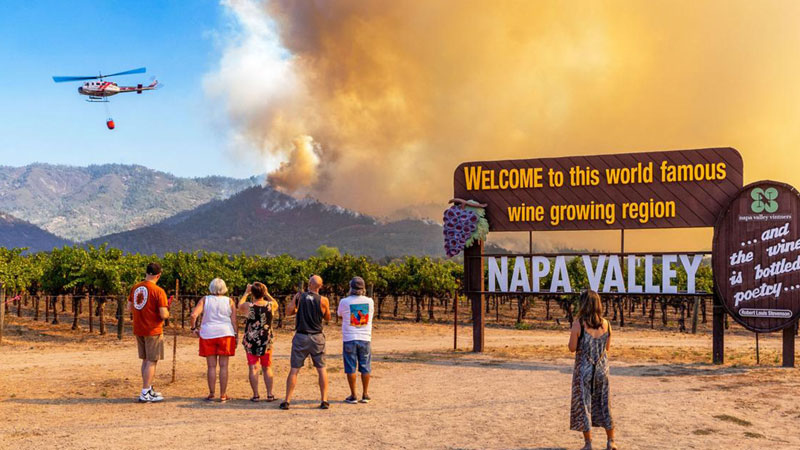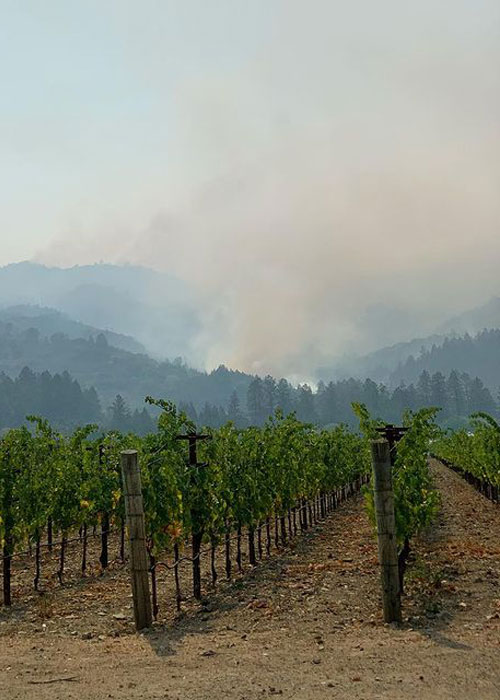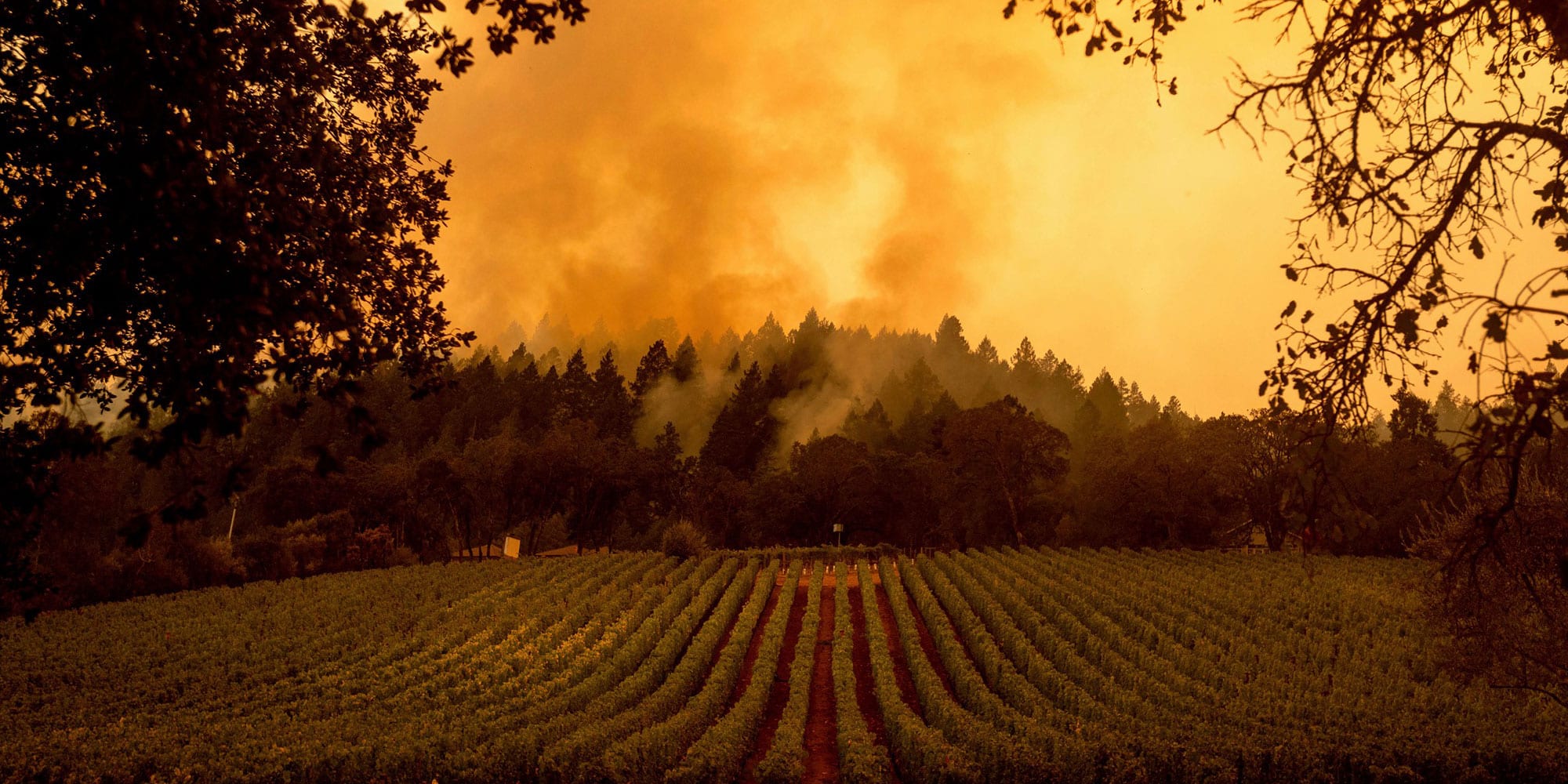How California Wineries Are Preparing for the 2021 Wildfire Season
Last year, wildfires burned through 4.2 million acres in California, making 2020 the worst wildfire season in the state’s modern history, according to Cal Fire. A rare August lightning storm sparked blazes all across the state, including the CZU Lightning Complex in the Santa Cruz Mountains, the LNU Lightning Complex in Napa, Sonoma, and other counties; and the massive August Complex in the Mendocino and Lake County regions. To make matters worse, the Glass fire hit Napa and Sonoma in late September, in the heat of harvest, damaging or destroying nearly 30 wineries and blanketing vineyards with thick, acrid smoke.
While it’s anyone’s guess if the state will ever again experience the unprecedented confluence of record-setting temperatures, high winds, and freak lightning strikes that led to 2020’s devastation, a dry winter and parched landscapes spurred by climate change have created the potential for another brutal wildfire season in 2021. Forty-one California counties, including Napa, Sonoma, and Mendocino, are already under drought emergencies as of May 11.
“Conditions right now are where we should be at a much later point in the year,” says Ben Nicholls, LNU division chief for Cal Fire, which is upgrading its current fleet of firefighting helicopters and bringing on 1,400 firefighters early to staff hand crews and fire engines. “We’re definitely concerned that things are only going to get drier as the year progresses.”
California vintners including Randall Grahm, founder of Bonny Doon Vineyard in the hard-hit Santa Cruz Mountains, share Nicholls’ unease: “The amount of rain we’ve received is just very, very low, and not really sustainable if we have another year like this,” Grahm says. “It’s just spooky to have any kind of dry vegetation and this much wind, because things can get out of control very quickly.”
In response, vintners across the state are ramping up their efforts to protect their wineries and vineyards in the coming months — and for the foreseeable future.


REGIONAL EFFORTS
In April, the Napa County Board of Supervisors approved a five-year, $42 million fire prevention plan presented by the nonprofit Napa Firewise Foundation. Years in the making, the initiative will focus on creating firebreaks — strips of bare soil designed to stop or control fire — in strategic locations, as well as clearing dry vegetation that could easily catch fire.
The Napa Valley Vintners association (NVV) is also implementing fire prevention and mitigation strategies. “Almost as soon as the wildfire situation subsided last fall, our leadership recognized that we can no longer cross our fingers and hope for the best,” Rex Stults, vice president of industry relations at NVV, says. “We’ve now had three significant wildfires in the Napa Valley since 2017, and we need to be more proactive in our approach to dealing with this.”
To that end, NVV formed a 50-vintner wildfire committee, along with three task forces: one dedicated to finding ways for winery owners to protect their own properties; a second to explore the county’s firefighting efforts; and the third focused on reducing wildfire fuels. “That means looking at ways for winery owners to harden their buildings or change the types of vents they have so embers can’t spread into building eaves,” says NVV director of industry relations Michelle Novi, who heads the task force devoted to individual winery mitigations.
Vintners are also installing perimeter sprinkler systems, clearing combustible brush around their properties, and training their teams to deal with smaller, spot fires. In the last few years, a handful of Napa Valley wineries — including Chappellet Winery, Regusci Winery, and Paloma Vineyards — have purchased retired fire trucks to defend their properties and those of their neighbors.
With increased fire prevention efforts underway across the county, Stults says, Napa Valley wineries will be better prepared in 2021 than in any previous year. “Overall fuel reduction measures are happening as we speak, and they can’t happen soon enough if the weather continues to be hot, dry, and windy,” he says.
Sonoma County wineries are also busy preparing for the coming season. “Wineries are increasing the defensible space around their properties, and some are even putting fire hose outlets on their estates,” Michael Haney, director of Sonoma County Vintners, says. “There are a couple of wineries that have their own fire teams now, and have procedures in place for what to do if a fire breaks out.”
Others, such as Lambert Bridge Winery in Dry Creek Valley, an AVA of Sonoma County, which had a close call with wildfires in 2020, are undertaking major fuel-reduction efforts and installing high-tech sprinkler systems.
“We’ve done six figures worth of fuels work, which is basically going into the forest behind the winery and taking out all of the dead and downed trees, cutting trees that are less than eight inches in diameter, and really opening up the forest canopy and floor,” explains vice president and general manager Bill Smart. “The work lasted about 45 days, with a crew of 20 on the property six days a week.”
Next year, Lambert Bridge will invest another $50,000 to $75,000 to add a high-powered watering system custom designed by Chico-based Firestorm Wildland Fire Suppression.
“The sprinklers basically look like guns on a pirate ship. They spin 360 degrees and shoot out 60 gallons per minute of water in a 100-yard radius,” Smart says. “The idea is that if there is an imminent fire, you could flip that on with an app on your phone, run it for 20 minutes, and keep whatever embers that show up on your property from igniting.”
Wineries in Sonoma County and other fire-threatened regions are also investing in backup power generators to keep fermentation tanks working during fire-prevention outages imposed by Pacific Gas and Electric, whose faulty equipment caused the deadly 2018 Camp Fire. “Basically if there’s a red flag warning, PG&E just turns the power off,” Smart says. “It’s become standard operating procedure out here.”


WHERE THERE’S SMOKE…
Along with stepping up their wildfire prevention efforts, California wineries are exploring tactics for dealing with potential smoke taint. In Monterey County, the issue in 2020 wasn’t so much fire as smoke, which wafted in from other areas and settled among the vines.
“We had to go to school on smoke mitigation super quick,” Kurt Gollnick, COO at Scheid Family Wines, says. This involved poring over scientific studies, measuring for volatile compounds in the grapes, and sending out samples for lab testing. The winery also ran grapes through a flash détente machine — used primarily to improve color extraction and treat under-ripe grapes in tough vintages — to remove volatile smoke molecules.
“We didn’t have a smoke taint issue at all,” Gollnick says. “And as for the sneaker theory that once you put the wine in the bottle, the taint’s going to get you later? It’s just not happening.”
If smoke blankets the vineyards again this season, the winery will be prepared: Scheid now has protocols in place to mitigate the effects. “You might say that we got good at dealing with smoke,” Gollnick says. “I think we’re in good shape to manage that now.”
At Bonny Doon in Santa Cruz, Grahm is proposing that some of the grape growers he works with spray their vines with kaolinite clay, which can help protect grapes from heat stress and smoke taint.
Whatever happens during the 2021 wildfire season, California vintners and grape growers will be primed for battle — as least as much as anyone can be when dealing with the unpredictable forces of nature.
“Every winery that we talk to, fire prevention is surely front and center on their minds, and they’re doing whatever they can to mitigate the risks,” Haney of Sonoma County Vintners says. “It’s imperative that our county, our state, our industry — that we all work together and try to be as prepared as possible.”
Medio: Vinepair
